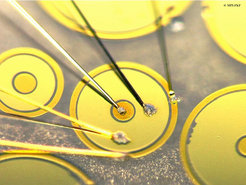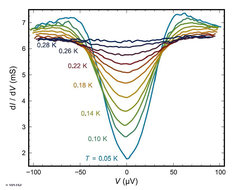Tunnel Spectroscopy of Superconducting Oxide Interfaces
By joining LaAlO3 and SrTiO3, a conducting two-dimensional electron liquid (2DEL) is formed at the contact area where these insulators meet [1]. At low temperatures this liquid is a two- dimensional superconductor [2] in which superconductivity surprisingly coexists with magnetic order [3–5]. Although interface superconductors are rare and have been recognized as candidates for superconductivity at very high temperatures (see, e.g., [6, 7] for recent publications), knowledge of the superconducting phase at the LaAlO3–SrTiO3 interface is very limited. To gain direct information about this unusual two-dimensional superconductor, we explore it with the powerful method of tunneling spectroscopy.

Photograph of a typical Au–LaAlO3–SrTiO3 tunnel device.
The broad golden ring lies on top of the LaAlO3 layer, which serves as a tunnel-barrier between the 2DEL and the Au. The outer ring and the center contact of the device are Au-covered Ti contacts to the 2DEL.
Figure 1 shows a photograph of the tunnel junctions that we designed and built for this purpose. The LaAlO3 layers, which generate the electron liquid and at the same time are used as tunnel barriers, were deposited on TiO2-terminated SrTiO3 substrates. To achieve a sizable tunnel current, most of the LaAlO3 films were grown to comprise only four monolayers of LaAlO3. This is the minimal thickness necessary to induce the interface electron liquid. On top of this LaAlO3 film, we deposited a metallic layer of Au. The samples were subsequently patterned into ring-shaped tunnel junctions with outer diameters of between 0.4 and 1 mm. In this sample design, electric fields generated by voltages applied to the back of the SrTiO3 substrates can be used to tune the superconducting state by changing the carrier density of the two-dimensional electron system [8].

Temperature-dependent tunnel spectra in the superconducting state.
At low temperatures the tunneling provides direct information on the superconducting state. Figure 2 shows dI/dV (V) tunneling characteristics at temperatures below the superconducting transition. The characteristics reveal a clear superconducting gap and allow the gap of the 2DEL to be measured for the first time: it equals Δ (50 mK) ≈ 40 μV. This value is derived from fitting the data with a quasiparticle lifetime-broadened BCS s-wave quasiparticle density of states. The gap vanishes at 280 mK and the temperature dependence is well described by that expected from the BCS theory.

Illustration of the doping versus temperature phase diagram of the n-doped LaAlO3–SrTiO3 interface 2DEL and the p-doped high-Tc cuprates. The charge carrier density is given in units of charge carriers per 2-D unit cell.
The gate voltage dependence of the tunnel spectra holds a surprise in store. Instead of following the transition temperature, the superconducting gap increases with charge carrier depletion in both the over- and underdoped regions of the phase diagram. This situation is analogous to the mysterious doping dependence of the high-Tc-cuprate superconductors (Figure 3). As the LaAlO3–SrTiO3 interface is a much simpler system than the cuprates, it can be used as a model system for layered superconductors and we believe this will be of great help to scientists in the understanding of unconventional superconductivity.
This research was done in collaboration with scientists from the universities of Augsburg, Stanford, Cornell and the Paul Scherrer Institute.
For more information see:
Interface superconductor with gap behaviour like a high-temperature superconductor
C. Richter, H. Boschker, W. Dietsche, E. Fillis-Tsirakis, R. Jany, F. Loder, L.F. Kourkoutis, D.A. Muller, J.R. Kirtley, C.W. Schneider, and J. Mannhart
Nature 502, 528-531 (2013)
References
[1] Ohtomo, A. and H. Y. Hwang, Nature 427, 423 (2004).
[2] Reyren, N. et al., Science 317, 1196 (2007).
[3] Li, L. et al., Nature Physics 7, 762 (2011).
[4] Bert, J.A. et al., Nature Physics 7, 767 (2011).
[5] Dikin, D. A. et al., Physical Review Letters 107, 056802 (2011).
[6] Chaloupka, J. and G. Khaliullin, Physical Review Letters 100, 016404 (2008).
[7] Stephanos, C. et al., Physical Review B 84, 100510 (2011).
[8] Thiel, S. et al., Science 313, 1942 (2006).


